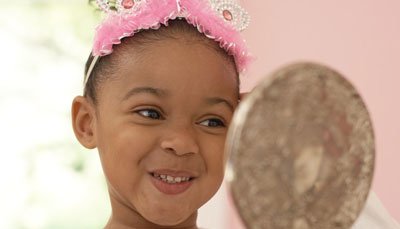514.223.5327
MAKE AN APPOINTMENTPreventing and Improving Poor Body Image
The image we have of ourselves is already largely formed at age 2 and once we develop beliefs and attitudes about ourselves – they are resistant to change. This highlights early childhood as a crucial period to prevent body image problems.
From infancy onward attune yourself to your children’s cues and help them to accurately label their feelings – whether these are emotional or physical. This helps children to identify and name what they are experiencing internally and their increasing ability to respond to these needs (i.e. rest when tired, eat when hungry) helps them to increase their sense of mastery and confidence.
Our children also need a lot of physical expressions of love: rocking, cuddling or physical contact during play. When kids experience consistent and soothing bodily contact they learn that the body is a source of pleasure and comfort.
Make family meals a peaceful time for enjoying food and being with each other. Save arguments, TV shows or phone calls for another time. Don’t use food as either a punishment or a reward.
Encourage children to explore their physical strengths. Let them experiment with different types of movement to give them the opportunity to experience their body as a positive, effective part of themselves. Children who are involved in physical activities have higher self-esteem – we especially see this effect on girls. Physical activity has many benefits – among them an increased sense of oneself as strong, healthy, coordinated and energetic.
Do not allow teasing about bodies in the house. Work towards identifying and resisting all forms of discrimination. Teach children what to do if they are teased at school. As teachers and coaches, we need to understand the detrimental effects of teasing and minimize this negative experience.
Be careful not to emphasize high achievement, perfectionism or competitiveness. These values increase the development of feelings of inadequacy and failure. We can encourage our children to do their best without needing to impress others with their performance.
Teach children how to critique the media constructively. Help them to deconstruct the messages that advertisements, television shows, music videos and even character roles in books tell us about how we should feel, act or look. Consider eliminating those that emphasize thinness such as some magazines. Letters of complaint can be sent to advertisers who promote harmful images and letters of appreciation can be sent to those advertisers that celebrate the natural diversity of human body shapes and sizes. Societal standards cannot harm us unless we let them.
Educate teenagers about bodily changes they can expect during puberty. We might share stories about how we felt when we were going through it. Sharing strategies about how to handle this period and gain perspective can also be helpful. Remind them that judgements based on appearances happen less often after high school.
Model a healthy self-perception. Learn about “set-point” weight and stop fighting with your body to be something that it’s not. Learn about the dangerous effects of dieting and give it up. Nurture your body by striving for balanced eating, physical activity and sufficient rest instead.
Do not use the body as an indicator for self-esteem. Encourage yourself and others to consider all of our qualities when evaluating ourselves. A strong sense of self that is not dependent on appearance is a resiliency factor for all kinds of problems. Parents or educators can do this by letting boys and girls know what is beautiful about them such as their kindness, strength, grace, intuitiveness, humor etc.
Learn how to identify symptoms of stress and model ways to effectively deal with stress.
Intentionally focus on positive aspects of the body. Get beyond appearance and include aspects such as movement and function. An example of this is to notice how fortunate we are that our bodies perform intricate and fascinating tasks for our well-being every day. Replace the negative ideas about our bodies with positive ones that are believable to us. This is a tough one for many of our clients. You cannot replace “I’m ugly” with “I’m beautiful” – it’s too big a leap. You can replace it with “my smile is beautiful” or even just setting an intention such as: “I am trying to notice and appreciate what I might come to love about myself”.
Surround yourself with people who respect a variety of body types and consider advocating to create safe spaces where teasing and “fat jokes” are eliminated.
If these ideas do not improve your body image consider getting professional support. Our clinicians are trained in the treatment of eating disorders and body image disturbances. Below you will find a list of resources which may be of interest to those of you who would like to read more.
Written by Shawna Atkins, Ph.D., OPQ
Canter, S. (2009). Normal Eating for Normal Weight: The Path to Freedom from Weight Obsession and Food Cravings. Permutations Software, New York.
Cash, T.F. (2008). The Body Image Workbook: An Eight-Step Program for Learning to Like Your Looks, second edition). New Harbinger, CA.
Friedman, S.S. (1997). When girls feel fat: Helping girls through adolescence. Harper Collins, New York.
Hirshman, J. & Zaphiropoulos, L. (1993). Preventing childhood eating problems: A practical positive approach to raising children free of food and weight conflicts. Gurze Books, CA.
Ikeda, J. & Naworsky, P. (1992). Am I fat? Helping young children accept differences in body size. ETR Associates, CA.
Koenig, K.R. (2005). The Rules Of “Normal” Eating: A Commonsense Approach for Dieters, Overeaters, Undereaters, Emotional Eaters, and Everyone in Between! Gurze, CA.
Pearson, A., Heffner, M., & Follette, V.M. (2010). Acceptance and Commitment Therapy for Body Image Dissatisfaction: A Practitioner’s Guide to Using Mindfulness, Acceptance, and Values-Based Behavior Change Strategies. New Harbinger, CA.
Pipher. M. (1994). Reviving Ophelia: Saving the Selves of Adolescent Girls. Ballantine Books, New York.
Web sites:
www.bodyimagecoalition.org
www.mindonthemedia.org/
www.aboutface.com
www.nedic.ca
www.edap.org
www.something-fishy.org
www.adiosbarbie.com

